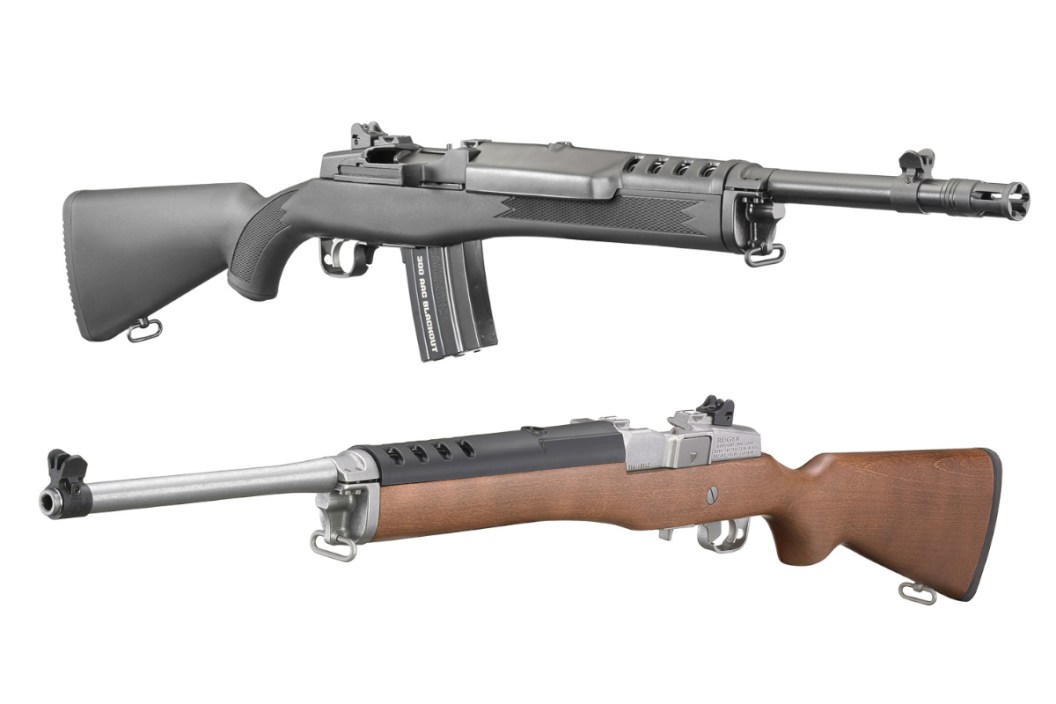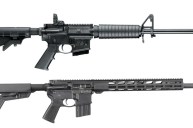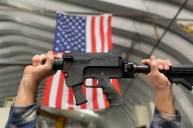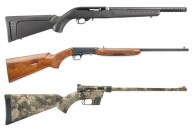The Ruger Mini-14 takes parts of its design from one of the most famous guns ever.
There is a plethora of options on the centerfire semi-automatic rifle market these days. Most people gravitate towards an AR or AK-style platform when looking for a tactical or semi-auto hunting gun. This leaves classic guns like the Ruger Mini-14 with a much lesser demand.
Still, there is quite a bit of interest in the classic Mini-14. There are few centerfire guns on the market that offer this rate of fire in a more traditional looking rifle. In many ways, it is a great "catch-all" gun for ranchers, hunters, and those simply interested in home defense.
Today we will run down a brief history on the Mini-14, why it is so popular, and we will attempt to answer some of the concerns about this interesting firearm. This is everything you ever needed to know about Sturm, Ruger & Co's Mini-14.
History and Specs of the Ruger Mini-14
We will do a very basic overview of the basics of this gun. Mostly because there are several different variants, and we would be here all day if we went through them all. The main thing to know is that this rifle has a breech bolt locking system, a rotating bolt and a fixed piston gas system design. Designers William Ruger and James Sullivan took a lot of inspiration from the legendary M1 Garand and the M14 rifle that replaced it. The Mini-14 is essentially a downsized version of the M14.
The big difference is in the size. The original M14s were about 44 inches long and weigh about ten pounds with a loaded magazine. Most Mini-14s come in with an overall length of just 38 inches and a weight just over seven pounds. The weight goes down to just over 6.5 pounds with some of the variants like the "Mini Thirty," and the Mini-14 Tactical models. The shorter profile of these guns gives them a length of pull between 11 and 15 inches on average.
All Ruger Mini-14 variants are fitted with barrels that are cold hammer-forged. The rate of twist is usually 1:9. Ruger has beefed up the barrels for these guns a bit. The newer models are a little more rugged than the older versions. Many of the tactical models have threaded barrels and feature a flash suppressor already installed. Barrel length varies. The bulk of the models have 18.5-inch barrels though, making for a compact package that is easy to swing on a moving target like a feral hog. They are available in either a blued or stainless steel finish.
Ruger builds the Mini-14 with a variety of stock configurations. Traditionalists will enjoy the traditional hardwood stocks offered for the the Ranch rifle and Mini-30 models. Users looking for a tactical rifle will appreciate the lighter black synthetic stock variants. Ruger sells one of their variants with a Strikeforce six-position stock and pistol grip. There are also tons of aftermarket options for this rifle, including some folding stock configurations to replace the traditional wood stock on an older model. It reminds us a lot of the Ruger 10/22 rimfire a way. The only limits to customization are the available parts and your imagination.
As far as sights, there is something for everyone. Most people use the Mini-14 with iron sights. Models with a rear aperture sight, ghost ring rear and bladed front sight are arguably the most popular. However, these rifles often feature integral scope mounts and picatinny rails for mounting optics. As for ammo options, Ruger has slowly expanded the offerings over the years too. The Mini-14 is available in .223 Remington, 5.56 NATO, 7.62x39mm, 6.8 SPC, and even .300 AAC Blk.
Why is Mini 14 so expensive?
If you have researched the Mini-14 before, you have likely noticed the prices. They are a bit of a shock considering you can get an AR platform for much less. The Ruger Mini-14 Ranch rifle has an MSRP of $1,279. Some of the tactical models have an MSRP around $1,300. The price in most big box stores is going to be less, generally anywhere from $800 to $1,000, but that still seems a bit pricey. As for why the price is so high, it seems the consensus with most gun owners is a combination of lower runs, material, and labor costs. The Mini-14 was first introduced back in 1973. When Ruger gave this gun a heavier barrel with more recent re-designs, it used more material, thus driving up the cost.
Ruger has also adjusted the fit and finish with many parts over the years, driving up material costs in those areas. Then there is the labor aspect. The video above is a few years old now, however, you can see that these rifles are being assembled almost completely by hand. And it is being done here in the states. Both of those factors are also going to drive up the costs, and the overall price of the gun in the end.
Keep in mind that the Mini-14 platform is never going to be as popular as an AR. We suspect that Ruger runs the M-14 in smaller runs than something like their AR-556 because the customer base is smaller. Running things in bulk is always going to shrink the costs more. It is probably a safe bet that all these factors combined are what drives up the cost of the Mini-14.
Why is the Ruger Mini 14 so inaccurate?
You will find very few gun owners who will complain about the way the Mini-14 cycles. It is, after all, basically a carbine variant of the classic M1 Garand. Mini-14s can feed five, 10, 15, 20, and even 30-round magazines easily with the Mini-14 Ranch or Tactical. The reliability of cycling is there. It is why the rifle is trusted by law enforcement agencies worldwide for responses to special situations.
However, the Mini-14 has a horrible reputation for being inaccurate. We believe a lot of this stems from that lighter barrel that was on the original guns. It heats up faster and is going to deform the barrel slightly, changing the point of impact after you have put a lot of rounds down range. Ruger may have changed the barrel, but old habits and opinions die hard, and the reputation of the gun persists.
There are also reports of problems with the gas blocks, inconsistencies in manufacturing, and harmonics issues. Some think the problems stem from a noticeable trigger creep. Keep in mind this rifle was not designed to be a precision machine that delivered sub-MOA groups at long distances. We suspect some people may be expecting too much from the gun.
It is worth noting that many of the Mini-14's accuracy issues have been addressed in recent years. In a strange reverse of how things usually play out, the newer Mini-14 models seem to enjoy a more favorable opinion than the old ones. You might consider taking your rifle to the gunsmith for some fine tuning if you experience nagging issues.
What are the practical purposes for the Mini-14?
The versatility of this rifle has no doubt helped it gain a following. The small profile of this gun, combined with the ability to use higher capacity magazines makes it an extremely useful ranch or brush gun. The size makes it easy to store behind a pickup seat or in a UTV while you are making your usual rounds of the property. Then, in a pinch, you can pull it out to take out a troublesome coyote or hog.
The Mini-14 also makes an ideal self-defense gun. Especially the chamberings for 5.56, 7.62x39mm or .223 Rem. Although we would lean more towards the Mini-14 tactical models for this purpose. Simply because they have better handguards, scope rings, swivels, and other accessories ideal for a defensive gun. These guns also come with 20-round magazines standard. More than enough for any home invasion scenario.
Is a Mini 14 worth the money?
This is the big question most users have, and the answer is going to vary from person to person. We have already mentioned the accuracy issues, which is the biggest thing to know. If accuracy is a huge concern, you might want to look at an AR-styled sporting rifle instead.
However, one big argument you can make for the Mini-14 over AR rifles is the style. The Mini-14 has a great, traditional, look. One you cannot get with other rifles. This style comes with another benefit for those who live in states with more restrictive gun laws like California. Since it has many features of a more traditional rifle, it is not as intimidating to non-gun owners. Thus, it is not as likely to fall prey to a lot of restrictions and "assault rifle" classifications as gun laws continue to evolve and change.
Overall, the Mini-14 is a solid rifle. It may be a little more expensive than some of the other options on the market, but they hold their value well. The versatility of this rifle is hard to beat too. Oh, and it is a blast on the range too. At the very least you should take the chance to shoot one before you buy. You may be surprised by finding a new favorite sporting rifle.
For more outdoor content from Travis Smola, be sure to follow him on Twitter and check out his Geocaching and Outdoors with Travis YouTube channels.
NEXT: THE 5 BEST HOME DEFENSE SHOTGUNS
WATCH









